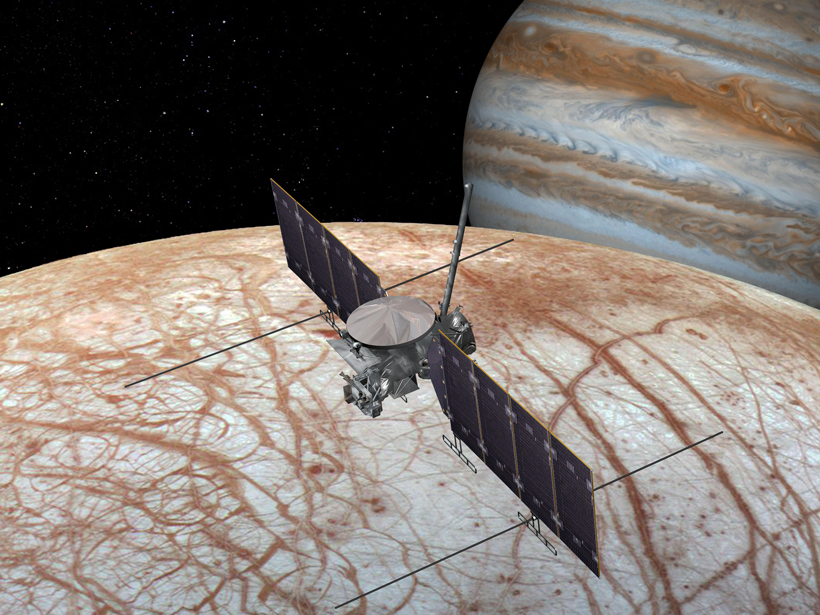A new budget that funds the U.S. government through the current fiscal year (FY 2017) maintains levels of funding comparable to FY 2016 for federal science agencies. President Donald Trump signed the budget bill into law today before the continuing resolution that is currently funding the government expired. FY 2017 ends on 30 September.
The Consolidated Appropriations Act of 2017 (H.R. 244), which the Senate approved yesterday following passage by the House earlier this week, stands in stark contrast to the administration’s stated goal of slashing nondefense discretionary funding to make room for more defense spending.
The $1.1 trillion omnibus bill, which provides some additional funding for defense and homeland security, does not heed the president’s 16 March request to cut $18 billion from FY 2017 nondefense discretionary funding. Nor does it mirror Trump’s FY 2018 budget blueprint that squeezed funding for Earth and space science agencies and other nondefense discretionary spending and cut funding for climate change programs.
Disagreements Between Congress and the White House
“At least for now, Congress is still interested in supporting science and technology.”
“At least for now, Congress is still interested in supporting science and technology, especially in prioritized areas like biomedical research and planetary science,” said Matt Hourihan, director of the R&D Budget and Policy Program at the American Association for the Advancement of Science in Washington, D. C.
“It may get a little harder in FY 2018 with an Administration so interested in rolling back most science programs, but research and development investment has historically been a bipartisan area of support for the Congress and odds are that won’t change,” he told Eos.
NASA Funding Boost
In the newly signed budget, NASA’s funding increases 1.9% to $19.65 billion compared to the budget for FY 2016. Funding for NASA’s Science Mission Directorate increases 3.16% to $5.77 billion, with Earth science funding at its FY 2016 level of $1.92 billion. Of that, $90 million will go to the climate-related Plankton, Aerosol, Cloud, ocean Ecosystem (PACE) satellite mission that the administration’s FY 2018 budget request proposed eliminating.
“People had expected more blanket cuts to discretionary spending. But generally, Congress likes to spend money.”
Planetary science will jump 13.2% to $1.85 billion. Within that total, $363 million is allocated for exploration of outer planets. That amount includes $275 million, which is $100 million more than FY 2016, for a mission to Europa, a moon of Jupiter that is suspected to harbor an ocean under its icy surface.
“People had expected more blanket cuts to discretionary spending. But generally, Congress likes to spend money,” said Casey Dreier, director of space policy for The Planetary Society, which is headquartered in Pasadena, Calif.
Dreier told Eos that planetary sciences and Earth sciences were not pitted against each other in the FY 2017 spending bill. “The pot grew bigger, which is everyone’s favorite way of dealing with the budget,” he said.
NSF Funding Even
National Science Foundation (NSF) funding nudges upward 0.1% to $7.47 billion. “This funding level will continue NSF’s longstanding commitment to making investments in basic research and people who make the discoveries that will grow our economy, sustain our competitive advantage, and enable the U.S. to remain the world leader in innovation,” Aya Collins, leader of the public affairs and media relations group in NSF’s Office of Legislative and Public Affairs, told Eos.
The new budget does not specify spending by NSF directorate. Agency director France Córdova had hoped that congressional funding directives would not wade into directorate-level funding for Geosciences and other agency directorates.
Funding for Other Agencies
In FY 2017, overall funding for the National Oceanic and Atmospheric Administration (NOAA) dips 1.6% to $5.68 billion. However, the largest percentage increase goes to NOAA’s Office of Oceanic and Atmospheric Research (OAR), whose budget rises 6.67% to $514 million. This is a dramatic difference from Trump’s FY 2018 proposal to cut OAR by 26%.
In the newly signed budget, funding for the U.S. Geological Survey (USGS) rises 2.2% to $1.085 billion. “I am hopeful this 2017 outcome is a positive sign of how our science is viewed and respected by Congress and bodes well for the future of this agency,” USGS acting director Bill Werkheiser told Eos before Trump signed the bill into law.
Within the Department of Energy, the Office of Science receives an increase of 0.8% to $5.39 billion. Funding for the Advanced Research Projects Agency–Energy (ARPA-E) increases 5.2% to $306 million.
In the budget, funding for the Environmental Protection Agency (EPA) declines 1% to $8.06 billion, despite the targeting of the agency for steep cuts in the new administration’s FY 2018 budget blueprint.
A Methodical Process
“Fiscal year [2017] was a classic three-party negotiation” between the White House, Republicans, and Democrats in which “everybody gets something but has to give up something,” according to Joel Widder, cofounder and partner of Federal Science Partners, a government relations consulting firm based in Washington, D. C.
“I think the appropriators went about their business in fairly methodical fashion and understood what it would take to get these bills passed to avoid a [government] shutdown, and to compromise when necessary,” he told Eos. “Also, I don’t think a lot of people—Republicans and Democrats—wanted to vote for huge nondefense cuts.”
—Randy Showstack (@RandyShowstack), Staff Writer
Citation:
Showstack, R. (2017), Newly signed federal budget is favorable to science, Eos, 98, https://doi.org/10.1029/2017EO073077. Published on 05 May 2017.
Text © 2017. The authors. CC BY-NC-ND 3.0
Except where otherwise noted, images are subject to copyright. Any reuse without express permission from the copyright owner is prohibited.

